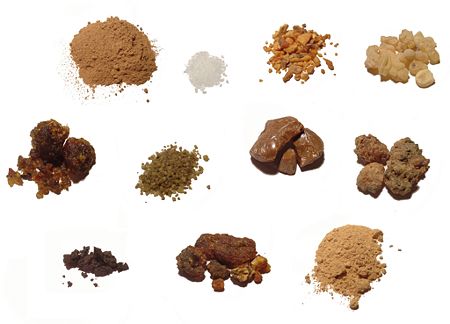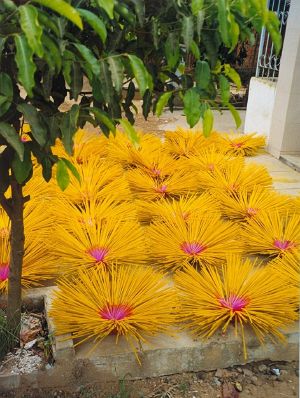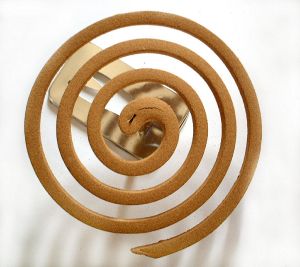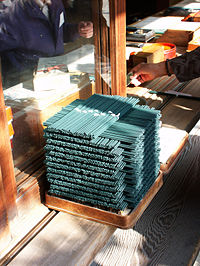Incense
Incense is composed of aromatic organic materials. It releases fragrant smoke when burned. The term incense refers to the substance itself, rather than to the odor that it produces.
Many religious ceremonies and spiritual purificatory rites employ incense, a practice that persists to this day. Incense is also used in medicine and for its aesthetic value. The forms taken by incense have changed with advances in technology, differences in the underlying culture, and diversity in the reasons for burning it.

Forms of incense
Incense is available in various forms and degrees of processing. However, incense can generally be separated into direct burning and indirect burnings types depending on how it is used. Preference for one form or another varies with culture, tradition, and personal taste.
Direct burning
Direct burning incense, also called combustible incense, generally requires little preparation prior to its use. When lit directly by a flame (hence the appellation) and then fanned out, the glowing ember on the incense will continue to smolder and burn away the rest of the incense without continued application of heat or flame from an outside source. This class of incense is made from a moldable substrate of fragrant finely ground (or liquid) incense materials and odorless binder. The composition must be adjusted to provide fragrance in the proper concentration and to ensure even burning. The following types of direct burning incense are commonly encountered, though the material itself can take virtually any form, according to expediency or whimsy:
- Coil: Shaped into a coil, the incense is able to burn for an extended period; from hours to days.
- Cone: Incense in this form burns relatively fast. Cone incense containing mugwort are used in Traditional Chinese medicine for moxibustion treatment.
- Cored stick: This form of stick incense has a supporting core of bamboo. Higher quality varieties of this form have fragrant sandalwood cores. The core is coated by a thick layer of incense material that burns away with the core. This type of incense is commonly produced by the Indians and the Chinese. When used for worship in Chinese folk religion, cored incensed sticks are sometimes known as Joss sticks.
- Solid stick: This stick incense has no supporting core and is completely made of incense material. Easily broken into pieces, it allows one to determine the specific amount of incense they wish to burn. This is the most commonly produced form of incense in Japan.
Direct burning incense of these forms is either extruded, pressed into forms, or coated onto a supporting material.
This might not be good, but for extruded or pressed incense, small quantities of water are combined with the fragrance and incense base mixture and kneaded into a hard dough. The incense dough is then pressed into shaped forms to create cone and smaller coiled incense, or forced through a hydraulic press for solid stick incense. The formed incense is then trimmed and slowly dried. Incense produced in this fashion has a tendency to warp or become misshapen when improperly dried, and as such must be placed in climate controlled rooms and rotated several times through the drying process.

Coating is used mainly to produce cored incense of either larger coil (up to 1 meter in diameter) or cored stick forms. The supporting material, made of either of thin bamboo or wood, is soaked in water or a thin water/glue mixture for a short time. The sticks are evenly separated then dipped into a tray of damp incense powder, consisting of fragrance materials and a plant based binder, usually makko (抹香・末香). 3 to 4 layers of damp powder are coated onto the sticks, forming a 2 mm thick layer of incense material on the stick. The coated incense is then allowed to dry in open air. Additional coatings of incense mixture can be applied after each period of successive drying. incense sticks that are burned in temples of Chinese folk religion produced in this fashion can have a thickness between 1 to 2 cm.
Incense base can also be formed into incense shapes without any fragrance material. These are purchased by hobbyists who immerse the preformed incense base in their own blends of essential oil mixtures to create their own direct burning incense.
Indirect burning
Indirect burning incense, also called non-combustible incense, is simply a combination of aromatic ingredients not prepared in any particular way or encouraged into any particular form, leaving it mostly unsuitable for direct combustion. The use of this class of incense requires a separate heat source since it does not generally kindle a fire capable of burning itself and may not ignite at all under normal conditions. This incense can vary in the duration of its burning with the texture of the material. Finer ingredients tend to burn more rapidly, while coarsely ground or whole chunks may be consumed very gradually as they have less total surface area. The heat is traditionally provided by charcoal or glowing embers. The incense is burned by placing it directly on top of the heat source or on a hot metal plate in the censer or thurible.
The best known incense materials of this type, at least in the West, are frankincense and myrrh, likely due to their numerous mentions in the Christian Bible. In fact, the word for "frankincense" in many European languages also alludes to any form of incense.
- Whole: The incense material is burned directly in its raw unprocessed form on top of coal embers.
- Powdered or granulated: The incense material is broken down into finer bits. This incense burns quickly and provides a short period of intense smells.
- Paste: The powdered or granulated incense material is mixed with a sticky and incombustible binder, such as dried fruit, honey, or a soft resin and then formed to balls or small cakes. These may then be allowed to mature in a controlled environment where the fragrances can commingle and unite. Much Arabian incense, also called Bukhoor or Bakhoor, is of this type, and Japan has a history of kneaded incense using this method.
Composition of incense
Incense composition requires more exactitude in the case of direct burning incense since it must be carefully proportioned and blended such that it has ability to slowly and evenly burn itself in its entirety.
While indirect burning incense consists mainly of fragrant materials and need not adhere to any specific proportion, recipes and mixes for all direct burning incense must include and balance two things: fragrant materials and a combustible base.
Fragrant materials
The fragrant materials provide the aroma and produce the fragrant smoke when incense is burned. Many types of fragrant woods, resins, herbs, and essential oils are used as incense individually or in combination. Many of the same fragrant materials are also commonly used in perfume formulations.
Raw materials
The following fragrance materials can be employed in either direct or indirect burning incense. They are commonly used in religious ceremonies, and many of them are considered quite valuable. Essential oils or other extracted fractions of these materials may also be isolated and used to make incense. The resulting incense is sometimes considered to lack the aromatic complexity or authenticity of incense made from raw materials not infused or fortified with extracts.
Plant-derived materials
Woods and barks
Seeds and fruits
Resins and gums
- Benzoin
- Copal
- Frankincense
- Myrrh
- Labdanum
- Dragon's blood
- Storax
- Galbanum
- Elemi
- Camphor
- Sandarac
- Guggul
- Opoponax
- Tolu balsam
Leaves
- Patchouli
- Sage
- Bay
- Tea
Roots and rhizomes
- Vetiver
- Orris
- Calamus
- Spikenard
- Galangal
Flowers and buds
Animal-derived materials
- Ambergris
- Musk
- Operculum
Essential oil fragrances
The following fragrances are but some of the many that can be utilized as essential oils. Incense deriving its aroma primarily from essential oils is usually cheaper than that made from unextracted raw materials.
Artificial fragrances
Artificial fragrances are normally used in the cheapest forms of incense. They are usually added to a base formed from charcoal powder. Typically, the essential oils from the following plants are not available, and therefore the presence of their aromas is a sign of ingredients derived from chemical synthesis.
- Cannabis
- Strawberry
- Opium
- Queen of the Night
- Lily of the valley
- Watermelon
Combustible base
The combustible base of a direct burning incense mixture not only binds the fragrant material together but also allows the produced incense to burn with a self-sustained ember, which propagates slowly and evenly through an entire piece of incense with such regularity that it can be used to mark time. The base is chosen such that it does not produce a perceptible smell. Commercially, two types of incense base predominate:
- Fuel and oxidizer mixtures: Charcoal or wood powder forms the fuel for the combustion. Gums such as Gum Arabic or Gum Tragacanth are used to bind the mixture together while an oxidizer such as Sodium nitrate or Potassium nitrate sustains the burning of the incense. Fragrant materials are combined into the base prior to formation as in the case of powdered incense materials or after formation as in the case of essential oils. The formula for the charcoal based incense is superficially similar to black powder, though it lacks the sulfur.
- Natural plant-based binders: Mucilaginous material, which can be derived from many botanical sources, is mixed with fragrant materials and water. The mucilage from the wet binding powder holds the fragrant material together while the cellulose in the powder combusts to form a stable ember when lit. The dry binding powder usually comprises about 10% of the dry weight in the finished incense. Makko (抹香・末香 incense powder), made from the bark of the tabu-no-ki tree (Machilus thunbergii) (jap. 椨の木; たぶのき), is perhaps the best known source of natural plant-based binder.
Qualitative Proportions
In order to obtain the desired combustion qualities, attention has to be paid to certain proportions in direct burning incense mixtures:
- Oil content: Resinous materials such as Myrrh and Frankincense must not exceed the amount of dry materials in the mixture to such a degree that the incense will not smolder and burn. The higher the oil content relative to the dry mass, the less likely the mixture is to burn effectively.
- Oxidizer quantity: The amount of chemical oxidizer in gum bound incense must be carefully proportioned. Too little, and the incense will not ignite, too much, and the incense will burn too quickly and not produce fragrant smoke.
- Mixture density: Incense mixture made with natural binders must not be combined with too much water in mixing, or over-compressed while being formed. This either results in uneven air distribution or undesirable density in the mixture, which causes the incense to burn unevenly, too slowly, or too quickly.
Uses of incense
Incense, being an article familiar to humanity since the dawn of civilization, has meant different things to the different peoples who have come to use it. Given the wide diversity of such peoples and their practices, it would be impossible to form an all-inclusive list of the ways in which incense has come to be used, since the methods and purposes of employment are as diverse and nuanced as those who have employed it.
Practical use of incense

Incense fragrances can be of such great strength that they obscure other, less desirable odors. This utility led to the use of incense in funerary ceremonies because the incense could smother the scent of decay. Another example of this use, as well as of religious use is the Botafumeiro which, according to tradition, was installed to hide the scent of the many tired, unwashed pilgrims huddled together in the Cathedral of Santiago de Compostela.
The regular burning of direct combustion incense has been used for chronological measurement in incense clocks. These devices can range from a simple trail of incense material calibrated to burn in a specific time period, to elaborate and ornate instruments with bells or gongs, designed to involve and captivate several of the senses.
Incense made from materials such as citronella can repel mosquitoes and other aggravating, distracting or pestilential insects. This use has been deployed in concert with religious uses by Zen Buddhists who claim that the incense that is part of their meditative practice is designed to keep bothersome insects from distracting the practitioner.
Aesthetic use of incense
Incense can be, like art for the eyes, music for the ears, or fine cuisine for the palate, an indulgence for the sense of smell. Many people burn incense to appreciate its smell, without assigning any other specific significance to it, in the same way that the forgoing items can be produced or consumed solely for the contemplation or enjoyment of the refined sensory experience. This use is perhaps best exemplified in the Japanese incense ceremony (香道 kōdō), where (frequently costly) raw incense materials such as agarwood are appreciated in a formalised setting.
Religious use of incense
Use of incense in religion is prevalent in many cultures and may have their roots in the practical and aesthetic uses considering that many religions with not much else in common all use incense. One common motif is of incense as a form of sacrificial offering to a deity.
Asian incense
Indian incense
Indian incense can be divided into two categories: masala and charcoal. Masala incenses are made of dry ingredients, while charcoal incenses contain liquid scents. Masala incenses have several subgroups.
Masala
Masālā is a word in Hindi (and other Indian languages) meaning "spice mixture." It is commonly used when referring to curries or other food dishes. Masala incenses are made by blending several solid scented ingredients into a paste and then rolling that paste onto a bamboo core stick. These incenses usually contain little or no liquid scents (which can evaporate or diminish over time).
- Dubars
Dubars are a sub-group of masala incense. They often contain ingredients entirely unfamiliar in the West and contain very complex scents. They are usually very slow-burning and are quite sweet and spicy in scent. They contain both solid and liquid perfumes in a binder which never quite dries out, making the incense sticks soft to the touch.
- Champas
Champas are a sub-group of durbars. They contain a natural ingredient indigenous to India called "halmaddi." Halmaddi is a grey semi-liquid resin taken from the Ailanthus Malabarica tree. It smells like the flowers of the plumeria tree. Plumeria flowers are known as champa flowers in India, hence the name of the incense group. Halmaddi is hygroscopic which means it absorbs moisture from the air. This can cause champa incenses to have a wet feeling to them. Nag Champa is probably the most famous incense of the champa group.
- Dhoops
Dhoops are another masala sub-group. They are an extruded incense, lacking a core bamboo stick. Many dhoops have very concentrated scents and put out a lot of smoke when burned. The most well-known dhoop is probably Chandan Dhoop. It contains a high percentage of Sandalwood.
Charcoal
Charcoal incenses are made by dipping an unscented "blank" (non-perfume stick) into a mixture of perfumes and/or essential oils. These blanks usually contain a binding resin (sometimes sandalwood) that holds the sticks' ingredients together. Most charcoal incenses are black in color.
Tibetan incense
Tibetan incense refers to a common style of incense found in Tibet, Nepal, and Bhutan. These incenses have a characteristic "earthy" scent to them. Ingredients vary from the familiar such as cinnamon, clove, and juniper, to the unfamiliar such as kusum flower, ashvagandha, or sahi jeera.
Many Tibetan incenses are thought to have medicinal properties. Their recipes come from ancient Vedic texts that are based on even older Ayurvedic medical texts. The recipes have remained unchanged for centuries.
Japanese incense
Agarwood (沈香 Jinkō) and Sandalwood (白檀 Byakudan) are the two most important ingredients in Japanese incense. Agarwood is known as "Jinkō" in Japan, which translates as "incense that sinks in water," due to the weight of the resin in the wood. Sandalwood is one of the most calming incense ingredients and lends itself well to meditation. The most valued Sandalwood comes from Mysore in the state of Karnataka in India.
Another important ingredient in Japanese incense is kyara (伽羅). Kyara is one kind of agarwood (Japanese incense companies divide agarwood into 6 categories depending on the region obtained and properties of the agarwood). Kyara is currently worth more than its weight in gold.
Nippon Kodō (日本香堂) is the largest seller of Japanese incense in Japan. Most of their incense is "Everyday" quality (毎日 mainichi). They do make some "Traditional" incense as well.
Shōeidō(松栄堂) and Baieidō (梅栄堂) are 2 of the oldest incense makers in Japan. They sell many of their Traditional incenses overseas. Kyūkyodō (鳩居堂), Kunmeidō (薫明堂), and Kōkandō (孔官堂) also sell some incense overseas.
Incense and health
Research carried out in Taiwan in 2001 linked the burning of incense sticks to the slow accumulation of potential carcinogens in a poorly ventilated environment by measuring the levels of polycyclic aromatic hydrocarbons (including benzopyrene) within Buddhist temples. Sitting in a smoky room, all day, every day for many years may expose individuals to cancer-causing chemicals.[1]. The scientists conducting the study noted that the rooms of concern had "visibility so low that you can't see clearly across the room." [Id.] They indicated that they were planning to conduct subsequent studies to determine whether the potential carcinogens actually affected individuals in the smoky temples but no such research seems to have been conducted. Several other studies in other countries showed no connection between exposure to incense smoke and developing lung cancer. [2] A survey of risk factors for lung cancer, also conducted in Taiwan, finds the burning of incense to be inversely correlated with adenocarcinoma of the lung.[3] A Taiwanese study has found gaseous aliphatic aldehydes, which are carcinogenic and mutagenic, in incense smoke.[4]
See also
- Incense Road
- Kyphi
- Silk Road
- Smudge stick
- Tea incense
ReferencesISBN links support NWE through referral fees
- Silvio A. Bedini. (1994). "The Trail of Time : Time Measurement with Incense in East Asia." Cambridge University Press. ISBN 0-521-37482-0
Credits
New World Encyclopedia writers and editors rewrote and completed the Wikipedia article in accordance with New World Encyclopedia standards. This article abides by terms of the Creative Commons CC-by-sa 3.0 License (CC-by-sa), which may be used and disseminated with proper attribution. Credit is due under the terms of this license that can reference both the New World Encyclopedia contributors and the selfless volunteer contributors of the Wikimedia Foundation. To cite this article click here for a list of acceptable citing formats.The history of earlier contributions by wikipedians is accessible to researchers here:
The history of this article since it was imported to New World Encyclopedia:
Note: Some restrictions may apply to use of individual images which are separately licensed.


